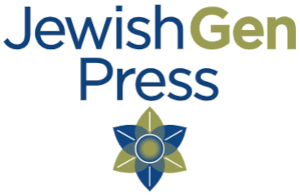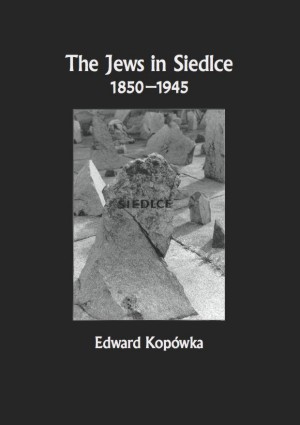

By Edward Kopówka
Published by the JewishGen Press
Hard Cover, 9.6” by 6.7”, 450 pages
Available from for $40.00
Click here to see the index containing the family names in this book. If you already have purchased the book, please print out and insert into the back of the book.
 |
Details:
This is the translation of Żydzi w Siedlcach 1850-1945 by Edward Kopówka from Polish into English.
The town of Siedlce is in Warsaw province in central-eastern Poland, about 55 miles east of Warsaw. A Jewish presence in Siedlce is attested since the mid-16th century. Just prior to World War II, it had a Jewish population of around 15,000. About 10,000 Jews were deported to Treblinka in August 1942; the remainder of the Jewish community was liquidated in November, 1942. This 450-page book chronicles the life of the Jewish community of Siedlce from the mid-19th century through its destruction during the Holocaust.
Dr. Edward Kopówka (b. 1963) is a writer, historian, and educator. He holds a Ph.D. degree from the Faculty of History of the Podlasie Academy in Siedlce and is Senior Curator of the Museum of Struggle and Martyrdom in Treblinka.
This book will appeal to scholars interested in the region or specializing in Jewish history and society as well as to Jewish genealogists seeking to trace their roots to Siedlce.
This book serves to commemorate the once vital community that no longer exists.
The Jews in Siedlce 1850–1945 This work consists of eleven chapters. The first chapter, “Siedlce and the Jews through the End of the Nineteenth Century,” presents the earliest traces of Jewish settlement as well as the development of Jewish and Polish communities in the city. The second chapter, “The Social and Political Life of the Jews of Siedlce at the Beginning of the Twentieth Century,” describes the complexities of the economic and political situation during this period. The third chapter, “The Pogrom of 1906,” includes information about this event, which was widely commented upon in the country and abroad.
The time span of the next chapter, “The Revival of Jewish Society during the Period 1915–1920,” requires more detailed explanation. When the Russian occupation ended in 1915 and Siedlce was occupied by German troops, the political life of local Jews started to flourish. The Germans did not object to social, political, and cultural activities, although they were subject to control. Local Jewish activists immediately took advantage of that historic moment, which continued until the Bolshevik invasion in 1920. The political revival among Poles, however, did not commence until 1918, when the Polish state was established. Some earlier unprecedented political events did, of course, take place, one of which was the manifestation on 3 May 1916. This chapter exemplifies the fact that Polish historic periods do not always correspond to Jewish ones.
The fifth chapter, “Political Aspirations of Jews during the Period 1918–1939,” provides an accurate description of all Jewish parties formed in the city. The sixth chapter, “Schooling,” includes a listing of schools and teachers on the basis of two criteria: language of instruction, and school profile (secular versus religious). The language of instruction that was chosen for the child at school often testified to his/her parents' political, social, and ideological outlooks. The seventh chapter, “Cultural-Educational, Welfare, and Health Organizations and Sports Clubs,” gives a broad account of the many organizations and their participation in the city's social life. The next chapter, “Internal Self-Rule and the Press,” provides information about the Jewish community and the variety of newspapers available. The ninth chapter, “Self-Help Organizations,” depicts both the history and the scope of activity of trade unions and cooperatives.
The tenth chapter describes the Jewish Holocaust, including the formation of the ghetto and its boundaries, health and sanitary conditions in it, as well as the stages of its liquidation. The account is supplemented by a register of labor camps for Jews, which served as sweatshops whose aim was the economic exploitation and physical exhaustion of workers. The last chapter, “After the War,” concentrates on both the unsuccessful attempts to revive the local Jewish community and the disappearance of material traces testifying to four centuries of a Jewish presence in the city of Siedlce.
The book is supplemented by numerous appendices containing sources that have not appeared previously in Polish historiography (an interview with Hubert Pfoch and an account of Fritz Hoeft). The enclosed literary works, in particular the short stories by Bracha Kahan, depict distinctive types of Jews, their life stories, and the atmosphere of old Siedlce. The book also includes numerous tables relating the numbers of Jewish citizens living in the city in different periods. Enclosed also are lists of monthly and yearly reports provided by various Jewish organizations present in the city between 1934 and 1938. They provide information about the number of meetings and gatherings that took place in the city and how many members participated in them. The book is supplemented by numerous photographs. So many of them have been included in this book because of their uniqueness and their depiction of a reality that no longer exists.
Alternate names: Siedlce [Polish], Shedlitz [Yiddish], Sedlets [Russian], Shedlits, Shedlets, Sedl'tse, Sedlce
Siedlce, Poland is located at: 52°10' North Latitude, 22°18' East Longitude, 55 miles East of Warsaw
|
 JewishGen Press
JewishGen Press
 JewishGen Home Page
JewishGen Home Page
Copyright © 1999-2024 by JewishGen, Inc.
Updated 17 Oct 2022 by LA